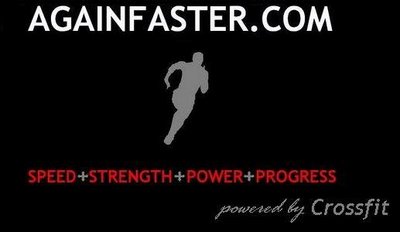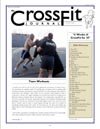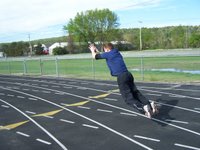Evolution

Within the framework of Crossfit, we progress from less- to more-difficult exercises, placing a premium on skill-based movements. These movements tend to pay greater fitness dividends than their simpler brethren.
For instance, the push jerk allows you to move a greater load than the push press over a similar distance, translating into increased work load and intensity. This leads to greater fitness.
Unfortunately, the push jerk is more difficult than the push press, requiring more coordination, balance, and agility. Instead of a simple dip and drive, the harder movement requires a dip, drive, dip sequence, demanding greater athletic skill.
Developing the harder movements is clearly to the athlete’s benefit. Success in this endeavour is contingent on practice through constant repetition. Given the immense size of the Crossfit curriculum, consistent practice on a variety of difficult skills becomes nearly impossible, leaving the athlete to practice these movements if and when they come up in the WOD.
The solution is simple. Evolve the warm-up.
At Crossfit Boston, we go through a rote warm-up, running through push-ups, pull-ups, sit-ups, squats, hip flexor stretches, and good mornings. None of these movements require a tremendous amount of skill, making them possible for nearly any athlete. While this sequence is highly beneficial to the novice/intermediate practitioner, it can be improved for a more advanced population.
Our advanced athletes have a good strength base and spectacular metabolic conditioning. They are typically reaching a plateau of organic improvement, where basic bodyweight exercises are not driving muscle growth or increased neurological capacity.
For these folks, the skill-based compound exercises are the next logical step in their training. The Olympic lifts, ring work, isometric strength movements, and plyometrics all beg for increased exposure. These exercises will drive athletic improvement much faster than their simpler cousins.
As we know, frequent, low-volume repetition develops increased capacity and proficiency. This principal, known as “greasing the groove”, has proven its efficacy again and again. By placing difficult exercises in the warm-up, we are engaging in this practice.
A sample warm-up:
Row 500 meters, followed by three rounds of:
5 Full Squat Cleans (75 pounds)
5 Snatches (75 pounds)
3 Muscle-ups
3 Skin-the-cats
1 Back Lever
1 L-sit (15 seconds)
In the preceding example, we engage the entire body in vigorous compound movement while preserving metabolic reserves for the upcoming workout of the day. Difficult skills are reviewed and reinforced. Ideally, this warm-up would be trainer supervised, giving the athlete constant feedback regarding proper execution.
Developing proficiency in the more-difficult movements is critical for the athletic development of the advanced Crossfitter. Toward this end, the warm-up period can be a fantastic resource, allowing frequent practice and increased exposure.
Go faster!
Check out Leo, warming up with some picture perfect snatches. Picture from the Again Faster Library.

Within the framework of Crossfit, we progress from less- to more-difficult exercises, placing a premium on skill-based movements. These movements tend to pay greater fitness dividends than their simpler brethren.
For instance, the push jerk allows you to move a greater load than the push press over a similar distance, translating into increased work load and intensity. This leads to greater fitness.
Unfortunately, the push jerk is more difficult than the push press, requiring more coordination, balance, and agility. Instead of a simple dip and drive, the harder movement requires a dip, drive, dip sequence, demanding greater athletic skill.
Developing the harder movements is clearly to the athlete’s benefit. Success in this endeavour is contingent on practice through constant repetition. Given the immense size of the Crossfit curriculum, consistent practice on a variety of difficult skills becomes nearly impossible, leaving the athlete to practice these movements if and when they come up in the WOD.
The solution is simple. Evolve the warm-up.
At Crossfit Boston, we go through a rote warm-up, running through push-ups, pull-ups, sit-ups, squats, hip flexor stretches, and good mornings. None of these movements require a tremendous amount of skill, making them possible for nearly any athlete. While this sequence is highly beneficial to the novice/intermediate practitioner, it can be improved for a more advanced population.
Our advanced athletes have a good strength base and spectacular metabolic conditioning. They are typically reaching a plateau of organic improvement, where basic bodyweight exercises are not driving muscle growth or increased neurological capacity.
For these folks, the skill-based compound exercises are the next logical step in their training. The Olympic lifts, ring work, isometric strength movements, and plyometrics all beg for increased exposure. These exercises will drive athletic improvement much faster than their simpler cousins.
As we know, frequent, low-volume repetition develops increased capacity and proficiency. This principal, known as “greasing the groove”, has proven its efficacy again and again. By placing difficult exercises in the warm-up, we are engaging in this practice.
A sample warm-up:
Row 500 meters, followed by three rounds of:
5 Full Squat Cleans (75 pounds)
5 Snatches (75 pounds)
3 Muscle-ups
3 Skin-the-cats
1 Back Lever
1 L-sit (15 seconds)
In the preceding example, we engage the entire body in vigorous compound movement while preserving metabolic reserves for the upcoming workout of the day. Difficult skills are reviewed and reinforced. Ideally, this warm-up would be trainer supervised, giving the athlete constant feedback regarding proper execution.
Developing proficiency in the more-difficult movements is critical for the athletic development of the advanced Crossfitter. Toward this end, the warm-up period can be a fantastic resource, allowing frequent practice and increased exposure.
Go faster!
Check out Leo, warming up with some picture perfect snatches. Picture from the Again Faster Library.




















1 Comments:
There was a Performance Menu article that changed up the CFWU. They made their moves plyometric. For instance instead of pushups they did clapping pushups, etc. Anyhow its time has come....
Post a Comment
<< Home